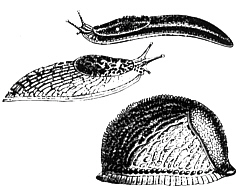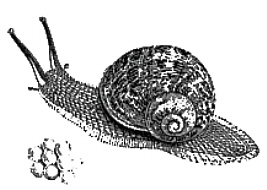QBARS - v30n4 A Beginner's Guide to Slugs and Snails
A Beginner's Guide to Slugs and Snails
George Waters, Berkeley, California
Reprinted with permission from Pacific Horticulture, April 1976.
Love's feeling is more soft and sensible
than are the tender horns of cockled snails.
-- Shakespeare, Love's Labour's Lost
|
|
No one new to gardening will remain for long unaware of the damage slugs and snails can do. These voracious little creatures are nocturnal feeders and the gardener may at first be unsure of the cause of damage to his plants, but the telltale silvery trail left by visiting snails and slugs will lead to the answer.
Damage done by slugs and snails can usually be recognized from the appearance of the wound. Their grazing mechanism is a sort of tongue, heavily equipped with teeth, called the radula. It resembles and is employed like a file, and damage on foliage, especially the heavy leaves of iris, often shows signs of the abrasive action by which plant tissue has been removed. It is not uncommon to find that the softer parts of leaves between the veins is eaten while the tougher tissue is left intact. Holes made in potatoes and in wheat seed invariably show an enlargement beyond the surface aperture, presumably because the softer tissue inside is preferred.
Young shoots of fleshy herbaceous plants seem to be their favorite food in the garden, but nothing is ignored. The bark may be stripped from a lemon tree by snails and fungi, lichen and even animal material have been found in the digestive tracts of collected slugs. Some species of slugs are cannibals.
Out of sight below ground, tiny slugs eat into bulbs and tubers. Thousands of tons of potatoes are lost every year because of slug damage and even the newly sown seed of spring wheat is sometimes destroyed, prior to germination, by slugs eating out the center. On farms slugs yield in economic importance to few other pests.
Slugs and snails are spread throughout the world. They belong to that enormous group of animals known as mollusks and within this group they have relatives on land, in the seas and rivers, collectively known as gastropods. Most mollusks, including gastropods, have a shell protecting part of their bodies, but slugs have evolved beyond that and are without shells. Some species of slugs show a patch on their backs which is differently textured from the rest of the back. The patch is called the mantle and is the vestigial location of the shell.
The lack of a shell has allowed slugs to succeed in a wider range of environments than can snails. The body shape is streamlined, allowing slugs to occupy cavities too small for snails; many slugs can therefore live below the soil surface. Having no shell, slugs need less calcium than snails, further extending their environment range.
The feature contributing most to the slugs' success (one shared with earthworms) is hermaphroditism. Within each animal are male and female organs producing ova and sperm simultaneously. Courtship and copulation nevertheless take place, usually at night and sperm is exchanged, thereby effecting cross fertilization. The sperm acquired during copulation can be stored and used gradually. In addition, some species can fertilize their eggs with their own sperm.
It is no wonder then that these creatures are so numerous and that they can multiply so quickly when their numbers have been reduced by disasters such as prolonged drought, or by onslaughts from determined gardeners.
Like the slugs themselves, their eggs are subject to desiccation in dry weather, but the main egg-laying season is autumn, when there is greatest chance of survival. Eggs are usually laid in small holes in the ground, enlarged and deepened by the parent if the soil is dry. Any number of eggs, up to a thousand, in groups of twenty to fifty, may be laid by a single slug in a season.
Their nocturnal habits protect slugs from predators to some extent, but they are eaten regularly by some birds, including starlings and gulls; but in no case do slugs represent a significant part of the birds' diet. Hedgehogs and some other small mammals eat slugs and so do certain insects such as carabid and staphylind beetle larvae, but by and large, the predators have little effect upon the slug population.
There are many things a gardener can do to control these creatures, although none is effective unless applied, diligently and frequently, each season. The first and most obvious method is to reduce the number of hiding places beneath which they can shelter during the day. Removing fallen leaves, large rocks, old flower pots and other debris will reduce their numbers in your own territory. Soil frequently hoed between the crop rows offers fewer hollows for shelter and egg laying. The movement of the hoe will kill some slugs while the surface soil is kept drier and less attractive to the survivors. Irrigation water, applied less often and less promiscuously will maintain in the garden a climate less hospitable to slugs and snails.
In some cases, simple sanitation of this sort may be enough to control slugs and snails but if the plants you favor are also the ones preferred by them, direct attack is imperative.
A simple form of warfare may be practiced at night with the aid of a flashlight, when the larger and more easily seen of these nocturnal creatures may be picked off the plants by hand and destroyed. Simple traps such as inverted half-grapefruit skins can be used to lure them to cool, dark places where they can be easily destroyed. I heard of one old gardener who trapped them with fragile bridges of bait (bran) built over small containers of salt water. Bait stations, using bran, can be located at intervals among crops and visited regularly each night to remove and dispatch the victims. A similar method, employing half a potato on a stick can be used to catch the small subterranean slugs. Since the creatures breed so prolifically, however, these measures are only rear-guard actions.
The use of sharp, scratchy material, like pine needles, cinders and broken egg shells, spread around vulnerable plants to deter slugs and snails, is often advocated. Enthusiasm for this method seems greatest among young gardeners. With the skepticism bred of many battles, older gardeners believe the pests will reach their objective over any obstacle.
Slugs tend to be fewer in sandy soils than in heavier clay soils and this may have given rise to the idea that their soft bodies are in some way sensitive to abrasion. However, it is doubtful if this difference in population is because of the scratchiness of sand compared with clay. A more likely explanation is that heavy soils retain a higher level of moisture in the top few inches than does sand, and slugs and snails require a moist medium to remain active.
The effectiveness of scratchy material as deterrent gains no support from laboratory tests in which the rate of travel of slugs was found to be unimpaired, even when their foot surface was damaged.
Among delphinium growers in England, aluminum sulphate crystals, sprinkled on the ground between plants, were favored to combat slugs and snails. This is the chemical used to induce blue flowers on some kinds of hydrangeas; it can also help to lower the pH of the soil. It is doubtful if aluminum sulphate kills the creatures; it is probably an irritant tending to cause dehydration and inactivity.
Bran is very attractive to slugs and snails and is used commercially, in combination with chemicals, to destroy them. Paris green, an arsenic compound, was once commonly used as the poison but has now been replaced with other materials believed to be safer. Metaldehyde, the active ingredient in Corry's Original English Formula and some others is still used. Unfortunately, metaldehyde is present usually only at about three per cent concentration and this allows many slugs taking the bait to recover in favorable weather. Careful tests have shown that a metaldehyde concentration, in bran, of five per cent is needed to ensure that slugs are killed by the preparation.
Carbamate compounds, originally developed as insecticides, have been found effective against slugs and snails and are generally more deadly for the purpose than metaldehyde. Carbamates, incorporated into pellets or granules of bran, are available as slug and snail killers produced by FortyNiner, Ortho, and Best.
Neither carbamates nor metaldehyde, in granules or pellets of bran, is very effective against the small black slugs living just below the soil surface. Severe infestations of these can be controlled with a liquid preparation of metaldehyde or a carbamate diluted with water and sprayed on the soil. However, all chemical preparations are expensive and inherently less desirable than the careful cultural practices mentioned earlier and should be employed only if all else fails. Carbamates are more toxic than metaldehyde to mammals and to other soil fauna including earthworms; they must be used, if at all, with caution.
Terrestrial Slugs by Runham and Hunter, Hutchinson, 1970, contains a summary of the results of many studies of slugs and much of the technical information for this article was drawn from it. The book also has a useful bibliography.


